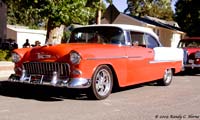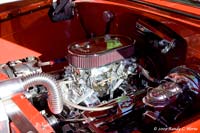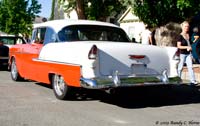












1955 Chevrolet Bel Air |
|||
| Classic and Hot Rod Cars And Their Stories | |||
 Front and Side View |
|||
| 1955 Chevrolet Bel Air Sport Coupe | |||
This story features a 1955 Chevrolet Bel Air sport coupe. This multiple trophy winning beauty is proudly owned by Jeff and Maryann Davis and was featured in the August 2005 edition of Chevy Rumble magazine. Davis has upgraded his baby “in the interest of safety”, a Camaro front clip included disc brakes and better steering and “Caddy” rear allowed for four wheel disc brakes. The latest upgrade is the 350 CID “roller” motor which was mated to a 700R4 four speed automatic transmission making this car a blast to drive. After two years of looking, Davis found this one at the Pomona auto swapmeet and the straight, no bondo body sold itself. The interior and chrome were redone and a good paint job completed the project after eight years. It only happens once in an engineer’s life time, when a company like Chevrolet hands you a blank sheet of paper and says: “Design us a car from scratch”. That’s the chance Edward Nicholas Cole was given with the 1955 Chevrolet in May of 1952. “We got a big kick out of designing this new Chevrolet, and you will get an even bigger one out of driving it”, said Ed Cole, Chevrolet Chief Engineer, describing the hot new Chevrolet. What made the new Chevy so popular, then and now? A completely new vehicle in styling and engineering as well as offering a new 265 cubic inch V-8 engine. With the option of a potent new “Turbo-Fire” V-8 it was the most changed and exciting Chevy since WWII. They started the design with a wider tubular frame chassis, new body styles, new engines, new front suspension, new rear springs and new brakes. The 115 inch wheelbase was 18% lighter and 50% stiffer than the previous version. 14 different solid colors and 23 different two-tone color combinations and over 50 accessories were available this year. Two-toning was very popular in the mid 1950s and Chevy had some of the best. On Bel Airs, the roof, rear deck and upper fenders were painted one shade and the body side color was painted another with chrome strip moldings separating the two toning. Interior variation was just as extensive, more plush and stylish. Instruments were symmetrically arranged directly ahead of the steering wheel in a simple fan shape matched on the right side by the radio speaker housing. An optional radio could be mounted between the two fan shaped clusters. Other improvements included changing from a 6 to 12 volt electrical system, new steering box with a 20:1 ratio, 11 inch diameter brake drums and under dash swinging pedals. The 1955 body design was boxy, yet altogether sleeker and fresher than the unexciting 1953 and 1954 models. Longer, lower and wider became General Motors new buzz words. Overall height was reduced 6 inches on station wagons and up to 3 inches on other models but was about one inch shorter and narrower than 1954. Hooded headlamps were blended into the new flat top front fenders, functional tail lamps extended out slightly from the sculpted rear fenders. From the Ferrari-like egg crate rectangular grille and eagle hood ornament to the stylish wrap around windshield, the 1955 Chevrolet was undeniably a winner. The Bel Air Sport Coupe two door hardtop was by far the most popular. Bel Airs were manufactured as 2 and door sedans, station wagons, Nomad station wagons and today’s highly sought after Convertible. There were 773,238 1955 Bel Air’s produced out of a grand total of 1,704,667 cars in the 1955 production year. The 1955 Chevrolet was a spectacular achievement for General Motors, seldom had a mass produced vehicle been so completely transformed in one year, a bright new youthful look and sizzling performance despite stronger than ever competition. On November 23, 1954 the 50 millionth automobile produced by General Motors in the United States rolled off a Chevrolet assembly line in Flint, MI. The car taking the honors was a 1955 Chevy Bel Air gold Sport Coupe 2-door hard top.
|
|||
Note: All Images And Stories On This Site Are Copywrited. Use Of Any |
|||
 Great Pricing & Selection of Cameras and Accessories: Top Camera Mall |
|||
|
|||


